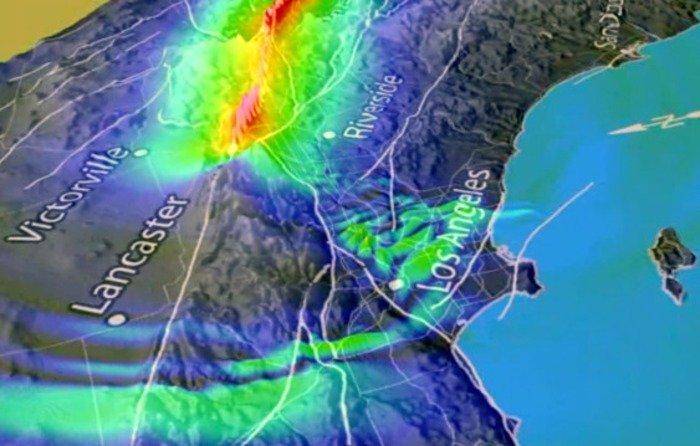This screenshot from a supercomputer simulation shows the waveguide-to-basin effect in Southern California, recently confirmed by Stanford researchers using a virtual earthquake approach. Credit: Courtesy of Southern California Earthquake Center
PALO ALTO, Calif., Jan. 24 (UPI) -- Los Angeles would experience stronger-than-expected shaking in a major earthquake, U.S. researchers producing "virtual earthquakes" say.
Scientists at Stanford University report using weak vibrations generated by Earth's oceans to produce "virtual earthquakes" to predict the ground movement and shaking hazard to buildings from real quakes.
The new technique has produced a prediction Los Angeles will experience stronger-than-expected ground movement if a major quake occurs south of the city, the university reported Friday.
"We used our virtual earthquake approach to reconstruct large earthquakes on the southern San Andreas Fault and studied the responses of the urban environment of Los Angeles to such earthquakes," said study lead author Marine Denolle, who recently received her doctorate in geophysics from Stanford and is now at the Scripps Institution of Oceanography in San Diego.
The researchers took advantage of the fact earthquakes aren't the only phenomenon that can produce seismic waves.
"If you put a seismometer in the ground and there's no earthquake, what do you record? It turns out that you record something," Stanford geophysics professor and study leader Greg Beroza said.
What is recorded is a weak, ongoing signal known as the ambient seismic field, generated by ocean waves interacting with solid Earth.
The researchers said they've devised a way to make the ambient seismic waves function as proxies for seismic waves generated by real earthquakes, allowing them to predict actions of much stronger waves from powerful earthquakes.
The technique suggests more variable, ground motion if a large earthquake -- magnitude 7.0 or greater -- were to occur along the southern San Andreas Fault south of Los Angeles near the Salton Sea.
"The seismic waves are essentially guided into the sedimentary basin that underlies Los Angeles," Beroza said. "Once there, the waves reverberate and are amplified, causing stronger shaking than would otherwise occur."















